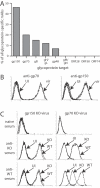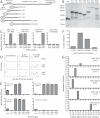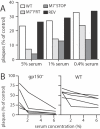The murine gammaherpesvirus-68 gp150 acts as an immunogenic decoy to limit virion neutralization
- PMID: 17684552
- PMCID: PMC1931612
- DOI: 10.1371/journal.pone.0000705
The murine gammaherpesvirus-68 gp150 acts as an immunogenic decoy to limit virion neutralization
Abstract
Herpesviruses maintain long-term infectivity without marked antigenic variation. They must therefore evade neutralization by other means. Immune sera block murine gammaherpesvirus-68 (MHV-68) infection of fibroblasts, but fail to block and even enhance its infection of IgG Fc receptor-bearing cells, suggesting that the antibody response to infection is actually poor at ablating virion infectivity completely. Here we analyzed this effect further by quantitating the glycoprotein-specific antibody response of MHV-68 carrier mice. Gp150 was much the commonest glycoprotein target and played a predominant role in driving Fc receptor-dependent infection: when gp150-specific antibodies were boosted, Fc receptor-dependent infection increased; and when gp150-specific antibodies were removed, Fc receptor-dependent infection was largely lost. Neither gp150-specific monoclonal antibodies nor gp150-specific polyclonal sera gave significant virion neutralization. Gp150 therefore acts as an immunogenic decoy, distorting the MHV-68-specific antibody response to promote Fc receptor-dependent infection and so compromise virion neutralization. This immune evasion mechanism may be common to many non-essential herpesvirus glycoproteins.
Conflict of interest statement
Figures






Similar articles
-
IgG fc receptors provide an alternative infection route for murine gamma-herpesvirus-68.PLoS One. 2007 Jun 27;2(6):e560. doi: 10.1371/journal.pone.0000560. PLoS One. 2007. PMID: 17593961 Free PMC article.
-
Vaccination with murid herpesvirus-4 glycoprotein B reduces viral lytic replication but does not induce detectable virion neutralization.J Gen Virol. 2010 Oct;91(Pt 10):2542-52. doi: 10.1099/vir.0.023085-0. Epub 2010 Jun 2. J Gen Virol. 2010. PMID: 20519454 Free PMC article.
-
Murine gammaherpesvirus 68 glycoprotein 150 does not contribute to latency amplification in vivo.Virol J. 2012 Jun 9;9:107. doi: 10.1186/1743-422X-9-107. Virol J. 2012. PMID: 22681851 Free PMC article.
-
Murine gammaherpesvirus-68 glycoprotein B presents a difficult neutralization target to monoclonal antibodies derived from infected mice.J Gen Virol. 2006 Dec;87(Pt 12):3515-3527. doi: 10.1099/vir.0.82313-0. J Gen Virol. 2006. PMID: 17098966 Free PMC article.
-
Virion Glycoprotein-Mediated Immune Evasion by Human Cytomegalovirus: a Sticky Virus Makes a Slick Getaway.Microbiol Mol Biol Rev. 2016 Jun 15;80(3):663-77. doi: 10.1128/MMBR.00018-16. Print 2016 Sep. Microbiol Mol Biol Rev. 2016. PMID: 27307580 Free PMC article. Review.
Cited by
-
The level of decoy epitope in PCV2 vaccine affects the neutralizing activity of sera in the immunized animals.Biochem Biophys Res Commun. 2018 Feb 12;496(3):846-851. doi: 10.1016/j.bbrc.2018.01.141. Epub 2018 Jan 31. Biochem Biophys Res Commun. 2018. PMID: 29374509 Free PMC article.
-
Antibody limits in vivo murid herpesvirus-4 replication by IgG Fc receptor-dependent functions.J Gen Virol. 2009 Nov;90(Pt 11):2592-2603. doi: 10.1099/vir.0.014266-0. Epub 2009 Jul 22. J Gen Virol. 2009. PMID: 19625459 Free PMC article.
-
Characterization of a novel wood mouse virus related to murid herpesvirus 4.J Gen Virol. 2010 Apr;91(Pt 4):867-79. doi: 10.1099/vir.0.017327-0. Epub 2009 Nov 25. J Gen Virol. 2010. PMID: 19940063 Free PMC article.
-
Carboxyl-Terminal Decoy Epitopes in the Capsid Protein of Porcine Circovirus Type 2 Are Immunogenicity-Enhancers That Elicit Predominantly Specific Antibodies in Non-Vaccinated Pigs.Viruses. 2022 Oct 27;14(11):2373. doi: 10.3390/v14112373. Viruses. 2022. PMID: 36366471 Free PMC article.
-
Recognition of the different structural forms of the capsid protein determines the outcome following infection with porcine circovirus type 2.J Virol. 2012 Dec;86(24):13508-14. doi: 10.1128/JVI.01763-12. Epub 2012 Oct 3. J Virol. 2012. PMID: 23035215 Free PMC article.
References
-
- Zinkernagel RM, Hengartner H. Protective ‘immunity’ by pre-existent neutralizing antibody titers and preactivated T cells but not by so-called ‘immunological memory’. Immunol Rev. 2006;211:310–319. - PubMed
-
- Sissons JG, Oldstone MB. Killing of virus-infected cells: the role of antiviral antibody and complement in limiting virus infection. J Infect Dis. 1980;142:442–448. - PubMed
-
- Xu J, Lyons PA, Carter MD, Booth TW, Davis-Poynter NJ, et al. Assessment of antigenicity and genetic variation of glycoprotein B of murine cytomegalovirus. J Gen Virol. 1996;77:49–59. - PubMed

